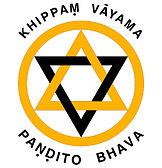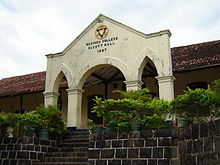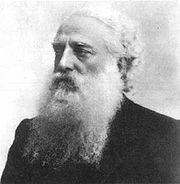- Mahinda College
-
Coordinates: 6°02′59″N 80°12′54″E / 6.04972°N 80.215°E
Mahinda College Crest of Mahinda College Khippam Vayama Pandito Bhawa
Meaning: ("Strive hard and be wise")Location Galle, Sri Lanka Information Type Government Public School Established 1892 Founder Colonel Henry Steel Olcott Principal R.M. Werahara Staff 175 Grades 1 to G.C.E. (A/L) Gender Boys Age 6 to 19 Enrollment 3750 Pupils Mahindians Color(s) Black and Gold Publication Sahasa Magazine Affiliation Buddhist Website http://www.mahindacollege.lk Mahinda College is a Buddhist boys' school in Galle, Sri Lanka. It is a national school, which provides primary and secondary education. The school was established on March 1, 1892 by the Buddhist Theosophical Society led by Colonel Henry Steel Olcott.[1] Mahinda College is one of the oldest and leading Buddhist schools in Sri Lanka.
Contents
History
Colonel Henry Steel Olcott, a retired United States army officer was in search of truth. He studied various philosophies and listened to the sermons of various religious dignitaries. But his inquiring mind did not find an answer. In his search he came across a comprehensive report of the Panadurawadaya.[2] It was a report of a religious debate between Buddhist monks and Christian clergy. Olcott appreciated the contentions of the Buddhist monks and started corresponding with the outstanding Buddhist monks of Ceylon. This correspondence eventually led him to visit Ceylon.
Col. Olcott landed in Galle on May 17, 1880 in the company of Madame H. P. Blavatsky. They became Buddhists at the Wijeyananda temple in Galle.[3] Olcott and Blavatsky were grieved at the treatment the Buddhists, their institutions and the religion received at the hands of the colonial rulers and the Christian hierarchy. They identified that the greatest danger came from the proselytization of the Buddhist children through education. To combat this they founded the Buddhist Theosophical Society and set about opening up Buddhist English schools, for Buddhist children. He opened up the B.T.S. English school at Pettigalawatta on September 15, 1880. This school had a short existence and later with the arrival of Dr. Bowles Daly (LLD), an Irish clergyman and a theosophist, Mahinda College was opened on March 1, 1892 at Pedlar Street in Galle fort.[4] The school was named after Arhant Mahinda Thero, the Buddhist monk who brought Buddhism to Sri Lanka.
Dr. Daly was a good disciplinarian and a tireless worker. But he left after a very short period of one year.The ensuing period of nearly a decade saw the school simply drifting with a number of principals serving for short periods. However with the arrival of Mr. Frank Lee Woodward as principal on August 1, 1903, things took a turn for the better.[5] From the day Mr. Woodward became the principal, the school had slowly but steadily progressed. By December 1903 within 4 months after Mr. Woodward’s assumption of office as principal, the average attendance of the school had risen to 142 from 89. In the same month students had been sent for the Cambridge examination and in July 1904, a student of Mahinda, G.W.Perera had won the university scholarship. By 1905 there had been 246 boys on the roll. It was during that period that Col.Olcott visited the College twice in 1904 and 1906. The year 1907 had been a dark year for Mahinda. Both Col.Olcott and Muhandiram Thomas Amarasuriya had died in that year. On June 25, 1907, Mr. Henry Amarasuriya, the son of the later had been elected as the manager of the school.
In this time Mr. F.L.Woodward had been active with a plan to move the College to a place with surroundings more conductive to its healthy growth. Mrs. D.F.de Silva of Minuwangoda donated a land called “Devatagawatta” far from the madding crowd, in a salubrious and elevated plot of land. It was a magical charming hillock with enlivening beauty of the central highlands painted on its eastern sky. It had attracted the attention Mr. F.L.Woodward who had a high sense of aesthetic beauty. The panoramic view of the Sripada (Adam’s peak) also said that it is the most suitable place to a Buddhist school.[4] On January 15, 1908 at 2.14 p.m, Mr. Woodward had laid the foundation stone of the Olcott hall. In July and October of the same year, the foundation stones for the Amrasuriya block and Matara blocks had been laid by Mr. H.Amarasuriya, E.S.Balasuriya and D.N.Weeratunga respectively. On August 1, 1912 the new building had been ceremonially opened. With the shifting of the school to its present abode, the number of students had risen to 300. The first price giving commemorating the 21st anniversary of inauguration of the school and the ninth anniversary of Mr.Woodward’s arrival was also celebrated in 1912. Mr. A.D.Jayasinghe joined the staff in 1917. He was later appointed as the headmaster of the school. In 1919, Mr.F.L.Woodward left for Tasmania to devote the subsequent 33 years of his life to the task of editing and translating Buddhist texts to be published by the Pali Text Society, London.[5]
Unlike in the 1890’s Mr. Woodward was succeeded by capable men like Dr. Kalidas Nag, Mr. F.G. Pearce, Mr.W. A. Troupe and Mr. P.R. Gunasekara. But they served Mahinda College only for very short periods. They were succeeded by an eminent old boy of the college, Mr. Edgar Albert Wijesooriya in 1932. This can be termed the golden age of Mahinda. He retired in 1962 with the taking over of assisted schools by the government. Thereafter Mahinda College became a government Sinhala medium school.
Mr. Jayasena H. Gunasekara succeeded Mr. Wijesooriya. During his tenure of office many buildings came up and the school population was almost doubled. After the departure of Mr. Gunasekara Mr. C. K. Waidyarathne acted till the arrival of Mr. B. K. Silva. After him Mr.W. A. D. S. Gunathilake served Mahinda College for five years. His elevation to a higher post in the department of education led to the appointment of Mr. C.K. Waidyarathne as a permanent principal. He was succeeded by another old boy of Mahinda College, Mr. D. D. Jayasundara in 1987. With his departure in 1991 another old boy, Mr. M. Wickramasinghe was appointed principal in 1992. The centenary celebrations were held that year on a very grand scale. He went back to the department in 1994 and was succeeded by yet another old boy Mr. D.C.Nissanka de Silva who too joined the department in 1996. Mr. Silva was succeeded by Mr. D. K. Athukorala as the principal. Mr. Athukorala served Mahinda College for eight years. After him Mr. K.A.Susil Premanath and Mr. L.C. Karunasena served as the acting principals. Currently, Mr. R. M. Werahara who is an old boy of Mahinda, is the principal. He was appointed on December 3, 2008.
Henry Steel Olcott
Main article: Henry Steel OlcottMahinda College, as well as many other Buddhist Schools in Sri Lanka, owes its existence to Col Henry Steele Olcott, philanthropist and the founder of the Buddhist Theosophical Society. Having read a printed version of the ' Panadurawadaya ' of 1873, a public debate between Buddhist and Christian representatives on the correctness of each belief, Col Olcott was really impressed of the teachings in Theravada Buddhism, which were in line with his vision as a theosophist.[2] It resulted in him arriving in Sri Lanka to study more on Buddhism, and starting a branch of the Theosophical Society, first in Colombo and then in Kandy and Galle. He was ably supported by Venerable Migettuwatte Gunananda Thera , Venerable Hikkaduwe Sri Sumangala Thero, Venerable Walane Sri Siddhartha Thero and Venerable Ratmalane Dhammaloka Thero, along with Anagarika Dharmapala, Walisinghe Harischandra, and Sir.D.B. Jayatilaka.[2]
With Col. Olcott’s initiative and guidance, the theosophists identified that a major factor for the decline of Sinhala Buddhists was the lack of proper education facilities and the best solution was to make available educational institutes with a solid Buddhist religious background. It was under this theory that foundations were laid to the beginning of the "Buddhist Schools" in Sri Lanka, which include the likes of Mahinda College in Galle, Dharmaraja College in Kandy, Ananda College in Colombo and Maliyadeva College in Kurunegala.[2]
Frank Lee Woodward
 Frank Lee Woodward, the principal of Mahinda College from 1903 to 1919.
Frank Lee Woodward, the principal of Mahinda College from 1903 to 1919.
Frank Lee Woodward (1871-1952)[6] was born in Saham Toney in Norfolk, England, as the son of a vicar of the Anglican religion. He had an archetypal Victorian boyhood and attended a traditional English public school. He won a scholarship to Cambridge and later turned to teaching, which secured him a deputy headmastership. He joined the London Theosophical Society and was a great friend of Col. Henry Steel Olcott. Col.Olcott offered him the principalship of Mahinda College, which he accepted and nursed for 16 years.[5]
He was the principal of Mahinda College from 1903 to 1919. Woodward’s work at Mahinda College included taking classes in English, Latin, Pali, Buddhism and Art, in addition to the administrative duties associated with the position of principal of the school. With the assistance of Mudaliyar Gunaratne, Muhandiram Thomas Amarasuriya, Muhandiram Wickremasinghe and the benevolent Buddhist public, Mr. Woodward shifted the College to its present site and made it one of the leading colleges in the Southern Sri Lanka. His involvement went much further. He was the designer and architect of its buildings, personally supervised their construction, and often worked alongside with the masons.Mr. Woodward who has not only built buildings for Mahinda College gave it a soul – the Woodward tradition. This was done through precept and practice. He decided to leave the college in 1919.
Frank Lee Woodward spent his retirement in Rowella, Tasmania, translating Buddhist scriptures from Pali to English. A vegetarian, a mystic and a man of whimsy, he practiced yoga, wore a turban and lived alone, surrounded by Buddhist scriptures on thousands of palm-leaves.[5] He has translated eighteen of the forty-two volumes of the Pali texts into English and compiled the vast concordance of the Pali canon, which occupied the last fifteen years of his life.[5] He was an erudite Pali scholar and translator.[6] Mr.Frank Lee Woodward died in 1952.
Mahinda College today
The college today provides education to over 3750 students from grade 1 to 13.[7] Students are divided into five groups namely Primary, Junior, Secondary, Senior Secondary and Collegiate. The present principal of Mahinda College is Mr.R.M.Werahera, an old Mahindian. The college academic staff comprising 175 academically qualified teachers[7], most of them having university degrees or diplomas and some of them having masters. It has a non academic staff of about 30. Over the years, Mahinda College has earned its reputation in various areas of academic excellence as well as in sports. The college provides many facilities to the students to excel in education as well as in a number of extra curricular activities. The school's sports facilities include a Swimming pool, Cricket and athletics ground, Gym and a Basketball court.
Past principals
- 1892-1893 : Dr. Bowels Daly
- 1894 : Lovegrove
- 1895-1896 : O.A. Jayasekara (Acting)
- 1897-1898 : M. Balasubramaniya Mudlier
- 1898 : Gordon Douglas
- 1899 : O.A. Jayasekara (Acting)
- 1900 : M.J. Fernando
- 1901 : O.A Jayasekara
- 1902 : Mc Dougal
- 1903-1919 : F.L. Woodward
- 1919-1920 : Kalidas Nag
- 1920 : S de S Jayarathna (Acting)
- 1921-1923 : F.G. Pearce
- 1923-1926 : W.A. Troup
- 1926-1932 : P.A.Gunasekara
- 1932-1962 : E.A.Wijesuriya
- 1962-1974 : J.H. Gunasekara
- 1974-1975 : C.K Waidyarathnae (Acting)
- 1975-1978 : B.K Silva
- 1978-1983 : W.A.D.S. Gunatilake
- 1983-1987 : C.K Waidyarathnae
- 1987-1991 : D.D. Jayasundara
- 1992-1994 : M.Wickramasinha
- 1994-1996 : D.C.N. de Silva
- 1996-2004 : D.K. Athukorola
- 2004-2007 : K.A.Susil Premanath
- 2007-2008 : L.C.Karunasena
- 2008 - : R.M.Werahera
Houses
Students are divided into four houses.
- Gamunu -
- Thissa -
- Pandukabhaya -
- Parakrama -
These houses are named after four great ancient kings of Sri Lanka. Annual sporting events are held among these houses.
Clubs & Societies
- Do You Know Society
- Environmental Society
- Human Rights Society
- Buddhist Association
- Media Circle
- St. John Ambulance First Aid Unit
- Temperance Movement
- Mahinda College Choir
- Sinhala Literary Association
- English Drama Society
- Scouts Troop
- Space Science Society
- English Literary Association
- College Orchestras
- Cadet Corps
- Traffic Controlling Unit
- IT Club
- Interact Club
- United Nations Educational Circle
- Commerce Society
- Arts Society
- Science Society
Sports
- Athletics
- Chess
- Gymnastics
- Basketball
- Rugby
- Volleyball
- Soccer
- Cricket
- Baseball
- Table tennis
- Badminton
- Swimming
- Hockey
- Scrabble
- Billiard and Snooker
Lovers' Quarrel
Main article: Mahinda-Richmond Cricket EncounterLovers' Quarrel, also known as Mahinda - Richmond big match is an annual cricket match played between the first XI cricket teams of Mahinda College and Richmond College, Galle. The contest was started in the year 1905 under principals Rev. James Horne Darrel of Richmond College and Frank Lee Woodward of Mahinda College. Out of the big matches played up to now, Mahinda College has won 23 encounters while Richmond College has won 21.[8] Lovers Quarrel was last won by Mahinda College in the 2008 encounter, having broken a 30 year long deadlock of draws since 1978.[9] Mahinda College also has been the first school in Sri Lanka to webcast their cricket big match.
Notable alumni
Main article: List of Mahinda College alumniNotable teachers
- Arisen Ahubudu
- Ananda Samarakoon[10]
See also
- Arahat Mahinda
- Education in Sri Lanka
References
- ^ "Historical Context". Embassy of Sri Lanka, USA. http://www.slembassyusa.org/srilanka_us_relations/historical_context.html. Retrieved 15-08-2010.
- ^ a b c d Agarwal, Prof. C.V. (18 February 2010). "Revival of Buddhism and theosophists". Daily News. http://www.dailynews.lk/2010/02/18/fea01.asp. Retrieved 15-08-2010.
- ^ Oliveira, Pedro. "BIO". CWL World. http://www.cwlworld.info/html/bio.html.
- ^ a b "College Profile". Mahinda Club. 2003. http://www.mahindaclub.net/profile.html. Retrieved 15-08-2010.
- ^ a b c d e Heyward, Nigel (1990). "Woodward, Frank Lee (1871 - 1952)". Australian Dictionary of Biography Online. http://adbonline.anu.edu.au/biogs/A120636b.htm. Retrieved 15-08-2010.
- ^ a b Jayetilleke, Rohan L. (January 03, 2007). "Frank Lee Woodward erudite Pali scholar and translator". Budu Sarana. http://www.lakehouse.lk/budusarana/2007/01/03/Budu17.pdf. Retrieved 15-08-2010.
- ^ a b "School Profile". Mahinda College. http://www.mahindacollege.lk/Subs/sch_pro.htm. Retrieved 15-08-2010.
- ^ Mahadura, Gamini (March 14, 2010). "Richmond looks to break Mahinda stranglehold". The Sunday Times. http://sundaytimes.lk/100314/Sports/spt11.html. Retrieved August 16, 2010.
- ^ Tissera, Charit (24 March 2011). "Southern Sri Lanka awaits action at 106th Lover’s Quarrel". ThePapare. http://thepapare.com/index.php/sports/cricket/189-southern-sri-lanka-awaits-action-at-106th-lovers-quarrel. Retrieved 24 September 2011.
- ^ Saparamadu, Sumana (2006). "Ananda Samarakoon - The composer of our national anthem". Sunday Observer. http://www.sundayobserver.lk/2006/05/14/jun02.asp. Retrieved July 04, 2010.
External links
Categories:- Buddhist schools in Sri Lanka
- Boys' schools in Sri Lanka
- Educational institutions established in 1892
- National schools in Sri Lanka
- Schools with a Cadet Corps
- Schools in Galle
- Alumni of Mahinda College
Wikimedia Foundation. 2010.



